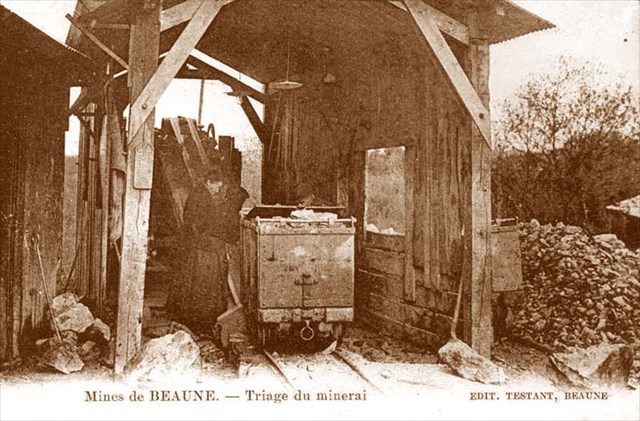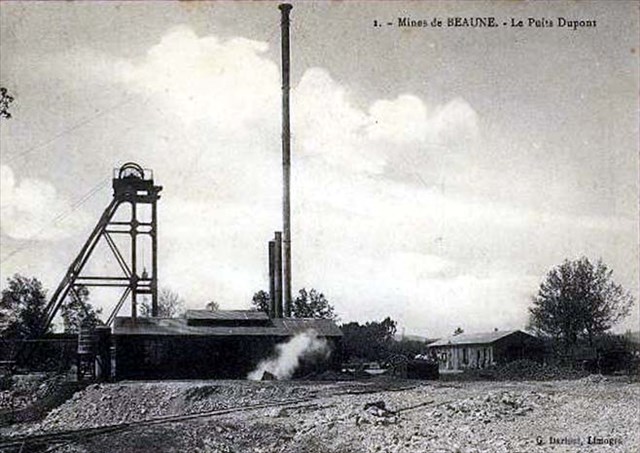Beaune : c'était une VER(T)itable mine d'or Traditional Cache
Beaune : c'était une VER(T)itable mine d'or
-
Difficulty:
-

-
Terrain:
-

Size:  (micro)
(micro)
Please note Use of geocaching.com services is subject to the terms and conditions
in our disclaimer.
[FR] Cette cache "park 'n grab" proche d'une sortie/entrée de l'autoroute A20 vous mènera dans un village au passé aurifère.
[EN] This cache "park ' n grab" close to an exit/entrance of the highway A20 will lead you in a village with au gold mining past .

------------oOo------------
 Triage du minerai à Beaune / Sorting of the ore in Beaune
Triage du minerai à Beaune / Sorting of the ore in Beaune[FR]
AVERTISSEMENT : Beaune-les-Mines est maintenant surtout une banlieue résidentielle de Limoges. Vous ne trouverez malheureusement plus aucune trace des mines sur le site de la cache. La cache est placée dans un lotissement. Le lieu a été choisi uniquement en guise de clin d'oeil à une équipe locale championne des FTF : la Belette team ... vous comprendrez pourquoi en arrivant sur place !
En revanche, vous pourrez prolonger votre visite par la cache de Mach87 (Village Les Mines - GC4TJ0E) qui vous permettra de découvrir quelques bâtiments, seul témoignage du passé minier de Beaune.
Beaune-les-Mines (Beuna en occitan) est un village de la Haute-Vienne englobé dans la commune de Limoges depuis 1962 (auparavant, le village était une commune indépendante). Anciennement Beaune, il doit son nom actuel de Beaune-les-Mines aux mines d'or exploitées essentiellement au 20e siècle (1912 à 1934).
Les Gaulois ont exploité de très nombreux sites dans la région dés le 5e siècle avant J.C et firent preuve de grandes connaissances empiriques en matière de prospection.
Dès l’an 400 avant Jésus-Christ, les Lémovices (habitants de Limoges) creusaient déjà des galeries dans les filons de quartz pour en extraire l’or. Au Moyen Age, Saint Eloi, patron des orfèvres, natif de Chaptelat (près de Beaune) encourageait l'orpaillage dans les sables des rivières de la région (notamment dans l'Aurence).
Les sites sont restés dans l'oubli jusqu'à la publication (1875) du répertoire des sites miniers antiques d'Ernest Mallard. De nouvelles prospections eurent lieu au début du 20ème siècle, et des sites furent remis en exploitation. Le gisement de Beaune les Mines produisit 288 kg d'or entre 1924 et 1931
La chute du cours de l'or en 1950 entraîna la fermeture de ces petites mines et ce n'est qu'en 1982 que la Société des Mines de Bourneix (filiale de la Cogema) remit en exploitation deux sites gaulois (Les Fouilloux et Cros Gallet). La teneur avoisine les 12/15 gr/tonne mais les moyens mécaniques actuels permettent une production de 2 t/an. Le traitement du minerai reste classique, cyanuration aprés concentration puis fixation sur du charbon actif.
Le district minier aurifère nord-limousin s'étend sur près de 3 000 km2 au nord de Limoges et comprend les anciennes mines de Vaulry, de Cieux, celles de La Petite Faye, de Baugiraud, de Beaune et d’Ambazac. L'or de Beaune est sous forme d'arsénopyrite aurifère (exploitée pour l'or, l'arsénopyrite aurifère est également le plus important minerai d'arsenic). L'exploitation des mines d'or a malheureusement entrainé une forte pollution des eaux et sédiments à l'arsenic.
La cache est une boîte micro qui permet la dépose et l'échange de très petits objets uniquement.
Suivant le challenge des caches "VERTes", le dépôt d'objets exclusivement "VERTs" sera apprécié.
 Puits Dupont
Puits Dupont
Ce puits est comblé mais s'est récemment rappelé au souvenir des habitants à cause d'un effondrement du sol.
This well is filled but recently reminded itself the memory of the inhabitants because of a collapse of the ground.
[EN]
WARNING : Beaune-les-Mines is now especially a residential suburb of Limoges.You will find unfortunately no more track of the mines on the site of the cache. The cache is placed in residential area. The place was only chosen by allusion to a local team champion of the FTF: the Belette team : you will understand why by arriving on the spot !
But you can extend your visit by the hiding place of Mach87 (Village Les Mines - GC4TJ0E) which will allow you to discover some buildings, only testimony of the mining past of Beaune.
Beaune-les-Mines (Beuna in Occitan language) is a village of the Haute-Vienne included in the municipality of Limoges since 1962 (previously, the village was an independent municipality). Formerly Beaune, he owes his current name of Beaune-les-Mines to gold mines exploited essentially in the 20th century (from 1912 to 1934).
The Gauls exploited very numerous sites in the region dice the 5th century before J.C and showed big empirical knowledge regarding prospecting.
From the year 400 before Christ, Lémovices (inhabitants of Limoges) already dug galleries in the veins of quartz to extract the gold from it. In the Middle Ages, Saint Eloi, patron of the silversmiths, native of Chaptelat (near Beaune) encouraged the gold washing in sands of the rivers of the region (notably in the Aurence).
Sites stayed abandoned until the publication (1875 ) of the directory of Ernest Mallard's antique mining sites. New prospecting took place at the beginning of the 20th century, and sites were put back in operation. The deposit of Beaune Mines produced 288 kg of gold between 1924 and 1931
The fall of the price of the gold in 1950 pulled the closure of these small mines and it is only in 1982 when the Company of the Mines of Bourneix (subsidiary of Cogema) put back in operation two Gallic sites (Fouilloux and Cros Gallet). The content borders 12/15 gr / ton but the current mechanical means allow a production of 2 the t / year. The ore processing remains classic, cyanidation aprés concentration then fixation(binding) on some activated charcoal.
The gold-bearing mining district North-Limousin extends over about 3 000 km2 in the North of Limoges and includes the old mines of Vaulry, Heavens, those of the Petite Faye, Baugiraud, Beaune and Ambazac. The gold of Beaune has the form of arsénopyrite gold-bearing (exploited for the gold, the gold-bearing arsénopyrite is also the most important ore of arsenic). The exploitation of gold mines has lead unfortunately a strong water and sediments and sediments with the arsenic.
The cache is a micro box which allows the removal and the exchange of very small objects.
According to the challenge of the "GREEN" caches (VERT in french), the deposit of exclusively "GREEN" objects will be appreciated.
Additional Hints
(Decrypt)
[FR] Cerarm yr cerzvre rager Puvyqéevp rg Guvreel, fnaf yr svyrgntr
[EN] Gnxr gur svefg orgjrra Puvyqéevp naq Guvreel, jvgubhg gur guernqvat
Treasures
You'll collect a digital Treasure from one of these collections when you find and log this geocache:

Loading Treasures